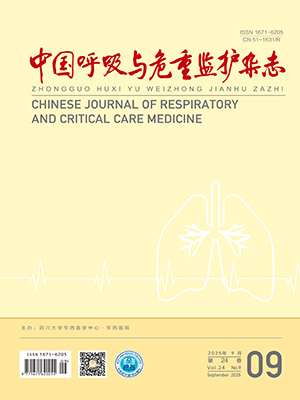| 1. |
Wang C, Xu J, Yang L, et al. Prevalence and risk factors of chronic obstructive pulmonary disease in China (the China Pulmonary Health [CPH] study): a national cross-sectional study. Lancet, 2018, 391(10131): 1706-1717.
|
| 2. |
Çolak Y, Afzal S, Nordestgaard BG, et al. Prognosis of asymptomatic and symptomatic, undiagnosed COPD in the general population in Denmark: a prospective cohort study. Lancet Respir Med, 2017, 5(5): 426-434.
|
| 3. |
彭显如, 黄敏於, 赵文驱, 等. 首诊慢阻肺错失早期诊断时间与疾病严重程度相关. 南方医科大学学报, 2018, 38(12): 1448-1452.
|
| 4. |
Aaron SD, Vandemheen KL, Whitmore GA, et al. Early Diagnosis and Treatment of COPD and Asthma - A Randomized, Controlled Trial. N Engl J Med, 2024, 390(22): 2061-2073.
|
| 5. |
Pavord ID, Beasley R, Agusti A, et al. After asthma: redefining airways diseases. Lancet, 2018, 391(10118): 350-400.
|
| 6. |
Pavord ID, Afzalnia S, Menzies-Gow A, et al. The current and future role of biomarkers in type 2 cytokine-mediated asthma management. Clin Exp Allergy, 2017, 47(2): 148-160.
|
| 7. |
丛舒, 姚洁宇, 樊静, 等. 2014-2015年中国慢性阻塞性肺疾病患者的患病相关知识知晓情况. 中华流行病学杂志, 2020(07): 1034-1040.
|
| 8. |
Fieldes M, Bourguignon C, Assou S, et al. Targeted therapy in eosinophilic chronic obstructive pulmonary disease. ERJ Open Res, 2021, 7(2).
|
| 9. |
David B, Bafadhel M, Koenderman L, et al. Eosinophilic inflammation in COPD: from an inflammatory marker to a treatable trait. Thorax, 2021, 76(2): 188-195.
|
| 10. |
Dalin DA, Løkke A, Kristiansen P, et al. A systematic review of blood eosinophils and continued treatment with inhaled corticosteroids in patients with COPD. Respir Med, 2022, 198: 106880.
|
| 11. |
Global Initiative for Chronic Obstructive Lung Disease. The global strategy for the diagnosis, management and prevention of chronic obstructive pulmonary disease. 2024. https://goldcopd.org/archived-reports/.
|
| 12. |
Lu Z, Huang W, Wang L, et al. Exhaled nitric oxide in patients with chronic obstructive pulmonary disease: a systematic review and meta-analysis. Int J Chron Obstruct Pulmon Dis, 2018, 13: 2695-2705.
|
| 13. |
Global Initiative for Chronic Obstructive Lung Disease. The global strategy for the diagnosis, management and prevention of chronic obstructive pulmonary disease. 2023. https://goldcopd.org/archived-reports/.
|
| 14. |
Miravitlles M, Soler-Cataluña JJ, Calle M, et al. Spanish Guidelines for Management of Chronic Obstructive Pulmonary Disease (GesEPOC) 2017. Pharmacological Treatment of Stable Phase. Arch Bronconeumol, 2017, 53(6): 324-335.
|
| 15. |
Gong Y, Sun H. Stability of Blood Eosinophils in COPD with Multiple Acute Exacerbations Within 1 Year and Its Relationship with Prognosis. Int J Chron Obstruct Pulmon Dis, 2022, 17: 3123-3128.
|
| 16. |
Whittaker HR, Müllerova H, Jarvis D, et al. Inhaled corticosteroids, blood eosinophils, and FEV(1) decline in patients with COPD in a large UK primary health care setting. Int J Chron Obstruct Pulmon Dis, 2019, 14: 1063-1073.
|
| 17. |
Hinds DR, DiSantostefano RL, Le HV, et al. Identification of responders to inhaled corticosteroids in a chronic obstructive pulmonary disease population using cluster analysis. BMJ Open, 2016, 6(6): e10099.
|
| 18. |
Annangi S, Nutalapati S, Sturgill J, et al. Eosinophilia and fractional exhaled nitric oxide levels in chronic obstructive lung disease. Thorax, 2022, 77(4): 351-356.
|
| 19. |
Peng X, Huang M, Zhao W, et al. [Delayed diagnosis is associated with greater disease severity of chronic obstructive pulmonary disease]. Nan Fang Yi Ke Da Xue Xue Bao, 2018, 38(12): 1448-1452.
|
| 20. |
Benson VS, Hartl S, Barnes N, et al. Blood eosinophil counts in the general population and airways disease: a comprehensive review and meta-analysis. Eur Respir J, 2022, 59(1).
|
| 21. |
MacLeod M, Papi A, Contoli M, et al. Chronic obstructive pulmonary disease exacerbation fundamentals: Diagnosis, treatment, prevention and disease impact. Respirology, 2021, 26(6): 532-551.
|
| 22. |
Trudo F, Kallenbach L, Vasey J, et al. Clinical And Economic Burden Of Eosinophilic COPD In A Large Retrospective US Cohort. Int J Chron Obstruct Pulmon Dis, 2019, 14: 2625-2637.
|
| 23. |
Müllerová H, Hahn B, Simard EP, et al. Exacerbations and health care resource use among patients with COPD in relation to blood eosinophil counts. Int J Chron Obstruct Pulmon Dis, 2019, 14: 683-692.
|
| 24. |
刘土轩, 彭敏, 刘旺, 等. 外周血嗜酸性粒细胞计数与慢性阻塞性肺疾病急性加重期患者呼出气一氧化氮及预后的相关性. 中国老年学杂志, 2023, 43(04): 817-821.
|
| 25. |
张彩云, 韩志海, 孟激光, 等. 稳定期COPD患者呼出气一氧化氮与外周血嗜酸性粒细胞水平的相关性分析. 解放军医学院学报, 2022, 43(04): 377-382.
|
| 26. |
Sunadome H, Matsumoto H, Izuhara Y, et al. Correlation between eosinophil count, its genetic background and body mass index: The Nagahama Study. Allergol Int, 2020, 69(1): 46-52.
|
| 27. |
Peerboom S, Graff S, Seidel L, et al. Predictors of a good response to inhaled corticosteroids in obesity-associated asthma. Biochem Pharmacol, 2020, 179: 113994.
|
| 28. |
Higham A, Beech A, Dean J, et al. Exhaled nitric oxide, eosinophils and current smoking in COPD patients. ERJ Open Res, 2023, 9(6): 00686-2023.
|




